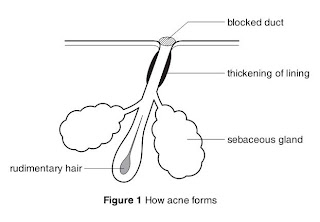
‘Acne is just when you get a load of spots all over your face. You
probably need to have about 20 for it to be bad.’
‘I think it is when you don’t wash and your face gets all spotty
and horrible.’
Acne is, in fact, the world’s most common skin disease. You know you have it when your skin develops blackheads, whiteheads, or red or yellow spots and becomes greasy. These are the classic signs and it doesn’t matter how many you have for your doctor to confirm it as acne. Acne doesn’t care who you are, what colour your skin is or how old you are. However, it is far more
likely that, as you approach puberty, your skin will start to change enough to kick-start the ‘acne process’. What most people don’t know is that you don’t always grow out of it: 15 per cent of
women in their 40s are still troubled by acne, although for men is it less likely to carry on for so long.
It’s a cruel fact that acne feels most at home on your face, butt can also crop up on your neck, back, chest or shoulders. This is because the oil-producing glands (the sebaceous glands) on your
skin are most concentrated here.
There has been extensive research into acne, and dermatologists blame four main factors in the skin:
- Firstly, the body seems to become extremely sensitive to the male hormones (the androgens) in the body. Women as well as men have male hormones but, because men have higher levels, they are often more affected. However, there do not have to be large amounts of these male hormones to get the oil-producing glands over-working, which makes them pump out more oil – called sebum.
- Secondly, these oil-producing glands have an opening into pores in the skin – small holes at the top of a tube or duct. At the bottom of the duct lies a hair follicle – specialised cells that are capable of producing a hair. The gland opens about half-way up the duct, which is lined by cells just like the ones on the surface of the skin. If you are affected by acne, these cells tend to clump together when they die and are shed, and cause the duct to narrow.
- Thirdly, the combination of this narrowing and the excess sebum results in the blockage – the starting point for all types of acne. This creates a wonderful environment for the acne bacteria that normally live on the skin: they start to multiply, which can lead to infection and inflammation.
- Fourthly, this inflammation then wakes up the body’s defence system, which sends white blood cells to fight the bacteria and repair the damage caused. These white blood
cells make up the bulk of what we see as pus – yellow or greenish fluid produced by the body in response to inflammation; it contains lots of white cells that come out of the blood stream to attack the cause of the inflammation. But, if the blockage doesn’t become infected, it will remain as a solid plug – or what we know as a blackhead.


Comments
Post a Comment